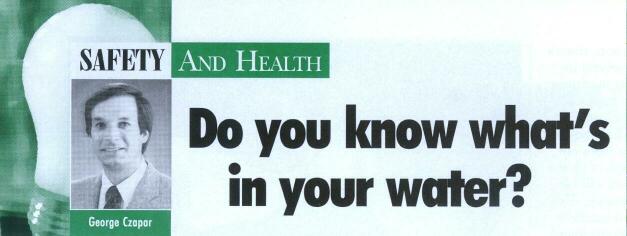 |
Home | Search | Browse | About IPO | Staff | Links |
 |
Home | Search | Browse | About IPO | Staff | Links |
|

Whether your water comes from a public utility or a private well, it is important you have high quality drinking water. Public water supplies must be sampled four times a year for more than 80 different contaminants. Since 1999, all public water supplies have provided their customers with an annual drinking water quality report developed by the U.S. Environmental Protection Agency (EPA) in consultation with water suppliers, environmental groups, and individual states. The report includes information about the source of drinking water, such as a lake, river or aquifer and whether it meets federal drinking water requirements. It explains how susceptible this local drinking water source is to contamination and identifies potential sources of contamination. It lists the contaminants detected in the water supply, and outlines the potential health effects of any contaminant found in violation of an EPA health standard. Consumer confidence reports are part of the right-to-know provisions in the 1996 Amendments to the Safe Drinking Water Act. They are aimed at improving public information about drinking water and increasing participation in water quality protection efforts. More information is available on EPAs drinking water Web site at: http://www.epa.gov/ogwdw or from the Safe Drinking Water hotline (800)426-4791. Although public water supplies are closely regulated and must meet EPA standards, private wells are not required to be tested. If the main source of your drinking water is from a private well, it is your responsibility to test the water on a regular basis. Water testing can be done by the Illinois Department of Public Health or by private labs. A basic test analyzes water for two common contaminants, coliform bacteria and nitrate. The best time to test for these contaminants is during spring or summer, following a period of heavy rainfall. These tests should also be conducted after repairing or replacing an old well and after installing a new well or pump. If coliform bacteria is detected in a water sample, there is some degree of contamination, and other organisms may also be present. Although chemical disinfectants such as chloride tablets or bleach can be used to treat wells, it is important to identify potential sources of contamination. Surface water or soil entering the well may indicate problems with well construction or location. High nitrate levels in water are a concern for pregnant women and infants under six months of age. Boiling the water will not reduce nitrate levels. If tests show that nitrate levels exceed 10 parts per million, water should not be consumed by pregnant women or infants under the age of six months. Two publications about water testing are available from your local University of Illinois Extension office. Planning Your Well: Guidelines for Safe, Dependable Drinking Water (Land and Water Publication Number 14), and Safe Drinking Water: Testing and Treating Home Drinking Water (Land and Water Publication Number 17). The U.S.EPA recently released a new guide for homeowners called, Drinking Water from Household Wells. The publication is available online at http://www.epa.gov/safewater/pwells1.html. Water testing is only part of a well owner's responsibility. Reducing the risk from potential contaminants is also important. Septic systems, for example, should be properly maintained to minimize the chance of groundwater contamination. Pesticides and fertilizers applied to the lawn and garden should be used carefully. Always follow the label directions for use and properly dispose of excess material. Similarly, used motor oil always should be recycled to prevent contaminating water supplies. Finally, abandoned wells are a threat to water quality and a significant health and safety concern. An abandoned well may allow contaminants to bypass the natural filtering process that takes place in the soil. Sealing an Abandoned Well (Cutting Edge 98-1) is a fact sheet available from your local Extension office. Information is also available at the Abandoned Well Web site at: http://dnr.state.il.us/orep/inrin/eq/well/trial.htm.
14 ILLINOIS COUNTRY LIVING www.aiec.org |
|
|